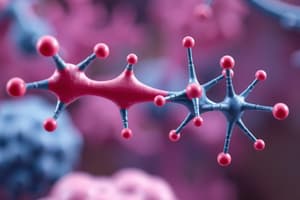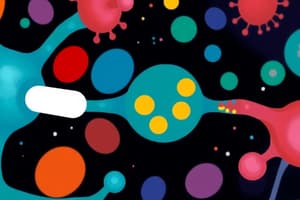Podcast
Questions and Answers
What is the mechanism of action for Avastin?
What is the mechanism of action for Avastin?
- It inhibits VEGF by preventing its binding to the kinase receptor. (correct)
- It enhances the signaling of the VEGF protein.
- It binds to the ES complex of VEGF and enhances its action.
- It acts as a competitive antagonist by binding to the same site as VEGF.
Which type of antagonist competes directly with the agonist for the same receptor?
Which type of antagonist competes directly with the agonist for the same receptor?
- Un-competitive antagonist
- Competitive antagonist (correct)
- Non-competitive antagonist
- Desensitization antagonist
What is the duration of validity for Schedule 2 and 3 controlled drugs?
What is the duration of validity for Schedule 2 and 3 controlled drugs?
- Valid for 3 months
- Valid for 28 days (correct)
- Valid for 12 months
- Valid for 6 months
Which of the following is NOT part of the accuracy check before dispensing medication?
Which of the following is NOT part of the accuracy check before dispensing medication?
What must occur when collecting a Schedule 2 or 3 drug on behalf of someone else?
What must occur when collecting a Schedule 2 or 3 drug on behalf of someone else?
What type of receptors are primarily responsible for mediating smooth muscle contraction in the guinea pig ileum?
What type of receptors are primarily responsible for mediating smooth muscle contraction in the guinea pig ileum?
What occurs when the interfacial region is saturated with amphiphilic molecules?
What occurs when the interfacial region is saturated with amphiphilic molecules?
What effect does atropine have on the ACh-induced response at lower concentrations?
What effect does atropine have on the ACh-induced response at lower concentrations?
What is the critical micelle concentration (CMC)?
What is the critical micelle concentration (CMC)?
Where is aspirin located in the micelles formed by sodium dodecyl sulfate (SDS)?
Where is aspirin located in the micelles formed by sodium dodecyl sulfate (SDS)?
What substance acts as a surfactant to reduce surface tension between molecules?
What substance acts as a surfactant to reduce surface tension between molecules?
Which factor affects the solubility of substances most notably?
Which factor affects the solubility of substances most notably?
What is a saturated solution?
What is a saturated solution?
What is the first step to take when assessing a casualty?
What is the first step to take when assessing a casualty?
What does the 'R' in DRABCs stand for?
What does the 'R' in DRABCs stand for?
When should a rescuer start CPR?
When should a rescuer start CPR?
What is the recommended rate for chest compressions during adult CPR?
What is the recommended rate for chest compressions during adult CPR?
What indicates that CPR should be stopped?
What indicates that CPR should be stopped?
How should surfactants orient themselves at an interface?
How should surfactants orient themselves at an interface?
What type of surfactant is sodium dodecyl sulfate (SDS)?
What type of surfactant is sodium dodecyl sulfate (SDS)?
What is the importance of checking for circulation only if the casualty is breathing?
What is the importance of checking for circulation only if the casualty is breathing?
What is the role of atropine when acting as a competitive antagonist?
What is the role of atropine when acting as a competitive antagonist?
How does the dose-response curve shift in the presence of a competitive antagonist like atropine?
How does the dose-response curve shift in the presence of a competitive antagonist like atropine?
What is the dose-ratio when calculating the effect of an antagonist?
What is the dose-ratio when calculating the effect of an antagonist?
What effect does an antagonist evoke on its own?
What effect does an antagonist evoke on its own?
What formula is used to calculate the molar concentration of a substance?
What formula is used to calculate the molar concentration of a substance?
What is the primary function of aeration in a tissue organ bath system?
What is the primary function of aeration in a tissue organ bath system?
What physiological response does acetylcholine (ACh) enhance in the ileum?
What physiological response does acetylcholine (ACh) enhance in the ileum?
What is a major distinction between an agonist and an antagonist?
What is a major distinction between an agonist and an antagonist?
What is the predicted effect of adding an additional methyl group to a surfactant according to Traube's Rule?
What is the predicted effect of adding an additional methyl group to a surfactant according to Traube's Rule?
Which of the following surfactants would likely form an insoluble monolayer due to insufficient water solubility?
Which of the following surfactants would likely form an insoluble monolayer due to insufficient water solubility?
What is necessary for weak electrolytes to dissolve into water?
What is necessary for weak electrolytes to dissolve into water?
Which type of materials can form an insoluble monolayer when injected onto a surface?
Which type of materials can form an insoluble monolayer when injected onto a surface?
Which of the following statements about phenobarb is true?
Which of the following statements about phenobarb is true?
What is the primary factor that allows weak electrolytes to dissociate in water?
What is the primary factor that allows weak electrolytes to dissociate in water?
In the context of Traube's Rule, which of the following surfactants is an exception?
In the context of Traube's Rule, which of the following surfactants is an exception?
What effect does increasing the length of a hydrocarbon chain in surfactants have according to Traube's findings?
What effect does increasing the length of a hydrocarbon chain in surfactants have according to Traube's findings?
What effect does low-dose adrenaline have on blood pressure?
What effect does low-dose adrenaline have on blood pressure?
Why should non-cardio selective beta blockers be avoided in asthmatics?
Why should non-cardio selective beta blockers be avoided in asthmatics?
What defines the clearance of a drug?
What defines the clearance of a drug?
How is the maintenance dose of a drug calculated?
How is the maintenance dose of a drug calculated?
Which type of antagonism involves an antagonist decreasing the overall concentration of an agonist at the active site?
Which type of antagonism involves an antagonist decreasing the overall concentration of an agonist at the active site?
What is the formula for calculating the half-life of a drug?
What is the formula for calculating the half-life of a drug?
What occurs when high doses of isoprenaline are administered?
What occurs when high doses of isoprenaline are administered?
What role does glucagon play in physiological antagonism?
What role does glucagon play in physiological antagonism?
Flashcards
Competitive Antagonist
Competitive Antagonist
A substance that competes with an agonist for binding to the same receptor, by binding reversibly.
Dose Ratio (DR)
Dose Ratio (DR)
The factor by which the dose of an agonist must increase to produce the same effect in the presence of an antagonist compared to without the antagonist.
Agonist Effect
Agonist Effect
Produces a 100% effect (or maximal) when binding to a receptor.
Antagonist Effect
Antagonist Effect
Signup and view all the flashcards
Molar Concentration
Molar Concentration
Signup and view all the flashcards
Aeration Importance (Tissue)
Aeration Importance (Tissue)
Signup and view all the flashcards
Acetylcholine (ACh) effect
Acetylcholine (ACh) effect
Signup and view all the flashcards
Agonist vs. Antagonist
Agonist vs. Antagonist
Signup and view all the flashcards
Muscarinic ACh Receptor (mAChR) types involved in ACh response
Muscarinic ACh Receptor (mAChR) types involved in ACh response
Signup and view all the flashcards
Effect of Atropine on ACh response
Effect of Atropine on ACh response
Signup and view all the flashcards
Solution Definition
Solution Definition
Signup and view all the flashcards
Solvent
Solvent
Signup and view all the flashcards
Factors affecting solubility
Factors affecting solubility
Signup and view all the flashcards
Surfactant function
Surfactant function
Signup and view all the flashcards
Amphiphilic molecule
Amphiphilic molecule
Signup and view all the flashcards
Critical Micelle Concentration (CMC)
Critical Micelle Concentration (CMC)
Signup and view all the flashcards
DRABCs
DRABCs
Signup and view all the flashcards
Agonal Breathing
Agonal Breathing
Signup and view all the flashcards
Chain of Survival
Chain of Survival
Signup and view all the flashcards
When to Stop CPR
When to Stop CPR
Signup and view all the flashcards
Surfactant
Surfactant
Signup and view all the flashcards
Counterion
Counterion
Signup and view all the flashcards
Interfacial Tension
Interfacial Tension
Signup and view all the flashcards
Micelle
Micelle
Signup and view all the flashcards
Traube's Rule
Traube's Rule
Signup and view all the flashcards
Surface Tension
Surface Tension
Signup and view all the flashcards
Hydrophilic and Hydrophobic Properties
Hydrophilic and Hydrophobic Properties
Signup and view all the flashcards
Insoluble Monolayer
Insoluble Monolayer
Signup and view all the flashcards
Surfactants at the Surface
Surfactants at the Surface
Signup and view all the flashcards
Formation of Insoluble Monolayer
Formation of Insoluble Monolayer
Signup and view all the flashcards
Types of Insoluble Monolayers
Types of Insoluble Monolayers
Signup and view all the flashcards
Weak Electrolyte
Weak Electrolyte
Signup and view all the flashcards
Reflex Tachycardia
Reflex Tachycardia
Signup and view all the flashcards
Beta-2 Vasodilation
Beta-2 Vasodilation
Signup and view all the flashcards
Alpha-1 Vasoconstriction
Alpha-1 Vasoconstriction
Signup and view all the flashcards
Isoprenaline's Action on Blood Pressure
Isoprenaline's Action on Blood Pressure
Signup and view all the flashcards
Non-Cardioselective Beta-Blockers in Asthmatics
Non-Cardioselective Beta-Blockers in Asthmatics
Signup and view all the flashcards
Clearance (Cl)
Clearance (Cl)
Signup and view all the flashcards
Volume of Distribution (Vd)
Volume of Distribution (Vd)
Signup and view all the flashcards
Elimination Rate Constant (Ke)
Elimination Rate Constant (Ke)
Signup and view all the flashcards
Antagonist types
Antagonist types
Signup and view all the flashcards
Non-Competitive Antagonism
Non-Competitive Antagonism
Signup and view all the flashcards
Un-Competitive Antagonism
Un-Competitive Antagonism
Signup and view all the flashcards
Desensitization
Desensitization
Signup and view all the flashcards
Study Notes
Drug Antagonism
- Four types of drug antagonism
- Chemical antagonism: interaction in solution affects drug availability
- Competitive antagonism: competition for same receptor site
- Physiological antagonism: opposing physiological effects through different pathways
- Non-competitive antagonism: inhibits response without direct competition for agonist binding site
PA2 Value
- Represents agonist potency
- Value that requires doubling the concentration of Ach (agonist) to get the same response as Atropine (antagonist)
- Higher PA2 value (less needed to block agonist) = Higher potency
- (the concentration of agonist at EC50 doubles)
- pA2 value indicates the concentration of antagonist needed to reduce agonist's effect by half
- Formula: PA2= - log[A], where [A] is the concentration of antagonist
Example of PA2 Calculation
- Drug X is an antagonist, and 2 x 10-6 M of Drug X doubles the effective concentration of an agonist needed to produce a response (from 5 μM to 10 μM)
- Using the formula, PA2 = - log(2 x 10-6) = 5.7
Agonist Potency
- Depends on affinity and efficacy.
- Affinity: strength of drug binding to receptor, influences receptor occupancy by the drug.
- Efficacy: ability of a drug to produce maximum biological response once bound to its receptor.
Drug Affinity
- Determined by specific interactions between drug and target receptor
- Influences likelihood and strength of drug binding.
- Equilibrium constant (KA): affinity of agonist for receptor; smaller KA = higher affinity.
- Equilibrium dissociation constant (KD): tendency of agonist-receptor complex to dissociate.
Drug Efficacy
- Receptor activation: efficiency with which a drug activates its target receptor
- Intrinsic activity: ability of drug-receptor complex to activate cellular processes; high intrinsic activity = more efficacious responses .
- Effector systems: influences downstream pathways.
- Receptor reserve: drug may be considered efficacious even if not all receptors are occupied
Competitive Antagonism
- Agonist and antagonist compete for same binding site on receptor.
- Both bind reversibly
- Reaction depends on two equilibrium constants (agonist-KA & antagonist- KAnt)
- If KAnt less than KA, antagonist has greater affinity for receptor, requiring increased agonist concentration to overcome antagonism.
Non-Surmountable Antagonism
- Antagonist cannot be overcome by increasing agonist concentration.
- Has persistent effect.
- Not easily reversed by higher agonist concentration.
Non-Competitive Antagonism
- Antagonist binds to a different site than the agonist.
- Reduces the number of available receptors for agonist (affecting overall response)
Irreversible Antagonism
- Antagonist binds irreversibly to either agonist or non-agonist binding sites.
- Reduces the number of available receptors.
- Reduces the slope and overall response.
Does Atropine act as a competitive or non-competitive agonist?
- Competitive Antagonist:
- Competes with ACh for binding to muscarinic receptors
- Produces an identical slope that shifts to the right without altering maximal response (efficacy)
- Bind reversibly.
Dose Ratio
- Dose-ratio: factor by which the dose of agonist must be increased to produce the same effect when antagonist is present
Full Agonist Effect
- A full agonist evokes 100% effect.
- Antagonists typically evoke 0% effect on their own
Molar Concentration Formula
- Conc(M) = Dose (g) / Body weight (kg) x MW (g/mol)
Acetylcholine (ACh) Action
- Increases rate and strength of contraction in ileal smooth muscle.
Agonist vs Antagonist
- Agonist: activate or enhance a biological response, mimic endogenous substances.
- Antagonist: block or inhibit a biological response.
Potential Receptors for ACh response
- Muscarinic Acetylcholine Receptors (mAChRs)
- M3 receptors mediate smooth muscle contraction
- M2 receptors may mediate inhibition and their blockade by atropine could enhance overall response
- Cholinergic Neurons: Interactions with pre- and post-synaptic receptors might contribute to observed effects.
Solution
- Consists of a single phase of two or more components, where components are dispersed at a molecular level.
- Solvent: the substance in which the solute dissolves.
Solubility Factors of Aspirin
- Temperature and polarity greatly affect solubility.
SDS (Sodium Dodecyl Sulfate)
- Surfactant that reduces surface tension between molecules.
- Functions in emulsification, foaming, and cleaning.
- Possesses both hydrophilic and hydrophobic groups (amphiphilic)
Micelles
- Form when interfacial region of amphiphilic molecules is saturated.
- Further reduction in surface tension is not possible
- Critical Micelle Concentration (CMC): concentration where surfactant forms micelles.
Aspirin Location in SDS Micelles
- Aspirin's aromatic ring is hydrophobic; located in the inner core of SDS micelles.
Traube's Rule
- Depends on the balance between hydrophilic and hydrophobic properties.
- Homologous series of surfactants: Increased length of hydrocarbon chain = increased surface activity = decreased surface tension.
- Every additional methyl = decrease in surface tension by 3.2
Insoluble Monolayers
- Surfactants exist in equilibrium with surfactant molecules in the bulk liquid.
- If the surfactant has a long alkyl chain, it has insufficient water solubility and forms insoluble monolayers at the surface.
- Heads down, tails out of water.
Weak Electrolytes
- Drugs that can act as weak acids or bases (often in salt form)
- Examples: Phenobarbital
DRABC (Casualty Assessment)
- Danger: Don't put yourself at risk
- Response: Check for any response (e.g., shouting)
- Airway: Open airway (tilt head back, lift chin)
- Breathing: Check for breathing (10 seconds)
- Circulation: Check for bleeding, but only if breathing is normal
- Resuscitation procedures (CPR)
Chains of Survival
- Recognize cardiac arrest
- Call emergency services
- Early basic life support
- Early defibrillation
- Early advanced life support
Surfactant (Amphiphile)
- Distinctive polar and non-polar regions (hydrophilic and hydrophobic)
- Polar regions can be: anionic, cationic, zwitterionic, or non-ionic.
Dispensed Drug Checks
- Accuracy: Labels, correct medicine, Patient information etc
- Legal: prescription details, date, CD requirements etc.
- Clinical checks: drug suitability for condition, any contraindications etc.
Studying That Suits You
Use AI to generate personalized quizzes and flashcards to suit your learning preferences.




